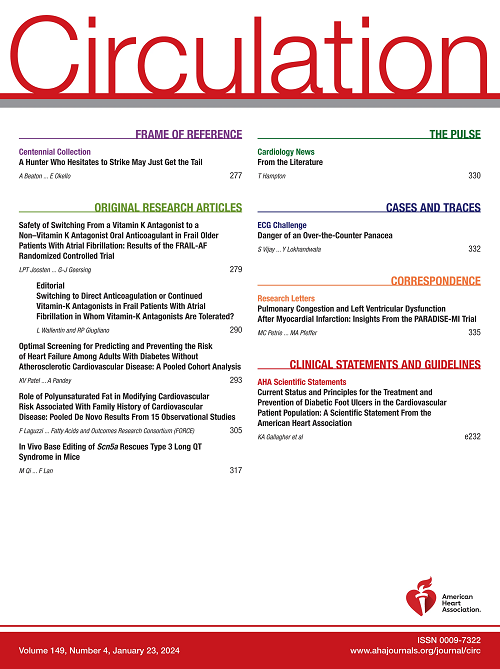东亚和欧洲血统人群中Lp(a)与冠心病和脑卒中类型的因果关系:一项孟德尔随机研究
IF 35.5
1区 医学
Q1 CARDIAC & CARDIOVASCULAR SYSTEMS
引用次数: 0
摘要
背景:血浆Lp(a)[脂蛋白(a)]水平升高是欧洲人冠心病和中风的一个因果危险因素,但Lp(a)与不同中风类型和具有不同Lp(a)遗传结构的东亚人之间的因果相关性尚不确定。方法:在一项巢式病例对照研究中,我们测量了18174名成年人(平均[SD]年龄,57岁;(49%女性)在中国嘉道里生物银行(CKB)进行了全基因组关联分析,以确定影响Lp(a)水平的遗传变异,并在英国生物银行的祖先特异性亚群中进行了复制。我们进一步进行了2个样本的孟德尔随机化分析,使用CKB和全基因组关联分析联盟的可用数据,将东亚和欧洲个体中具有心肌梗死(n= 17091)、缺血性卒中(IS [n= 29233])及其亚型或脑出血(n=5845)风险的CKB或已发表数据中衍生的祖先特异性Lp(a)相关工具变异关联起来。结果在CKB观察分析中,血浆Lp(a)水平与心肌梗死和IS的高风险呈对数线性正相关,但与ICH无关。在全基因组关联分析中,我们发现了29个与Lp(a)独立相关的单核苷酸多态性,它们共同解释了中国个体Lp(a) 33%的变异。在UK Biobank中,在CKB中鉴定的主要中国变异在1260名中国个体中被复制,但仅解释了欧洲个体Lp(a)变异的10%。然而,在孟德尔随机化分析中,Lp(a)在两个祖先中对所有心血管疾病结果的影响高度一致。在两个祖先的联合分析中,每100 nmol/L遗传预测Lp(a)水平降低的心肌梗死风险比例降低是总IS的3倍(比率比,0.78 [95% CI, 0.76-0.81]对0.94[0.92-0.96]),但与大动脉IS相似(0.80 [0.73-0.87];n = 8134)。与心脏栓塞性IS的相关性较弱(0.92 [95% CI, 0.86-0.98];n=11 730),与小血管IS无相关性(0.99 [0.91-1.07];N =12 343)或脑出血(1.08 [0.96-1.21];n = 5845)。结论:Lp(a)对心肌梗死和大动脉IS风险的影响在东亚和欧洲个体中具有可比性,这表明任何一种血统的人都可以期望同等程度的Lp(a)降低,但对其他卒中类型的影响很小。本文章由计算机程序翻译,如有差异,请以英文原文为准。
Causal Relevance of Lp(a) for Coronary Heart Disease and Stroke Types in East Asian and European Ancestry Populations: A Mendelian Randomization Study.
BACKGROUND
Elevated plasma levels of Lp(a) [lipoprotein(a)] are a causal risk factor for coronary heart disease and stroke in European individuals, but the causal relevance of Lp(a) for different stroke types and in East Asian individuals with different Lp(a) genetic architecture is uncertain.
METHODS
We measured plasma levels of Lp(a) in a nested case-control study of 18 174 adults (mean [SD] age, 57 [10] years; 49% female) in the China Kadoorie Biobank (CKB) and performed a genome-wide association analysis to identify genetic variants affecting Lp(a) levels, with replication in ancestry-specific subsets in UK Biobank. We further performed 2-sample Mendelian randomization analyses, associating ancestry-specific Lp(a)-associated instrumental variants derived from CKB or from published data in European individuals with risk of myocardial infarction (n=17 091), ischemic stroke (IS [n=29 233]) and its subtypes, or intracerebral hemorrhage (n=5845) in East Asian and European individuals using available data from CKB and genome-wide association analysis consortia.
RESULTS
In CKB observational analyses, plasma levels of Lp(a) were log-linearly and positively associated with higher risks of myocardial infarction and IS, but not with ICH. In genome-wide association analysis, we identified 29 single nucleotide polymorphisms independently associated with Lp(a) that together explained 33% of variance in Lp(a) in Chinese individuals. In UK Biobank, the lead Chinese variants identified in CKB were replicated in 1260 Chinese individuals, but explained only 10% of variance in Lp(a) in European individuals. In Mendelian randomization analyses, however, there were highly concordant effects of Lp(a) across both ancestries for all cardiovascular disease outcomes examined. In combined analyses of both ancestries, the proportional reductions in risk per 100 nmol/L lower genetically predicted Lp(a) levels for myocardial infarction were 3-fold greater than for total IS (rate ratio, 0.78 [95% CI, 0.76-0.81] versus 0.94 [0.92-0.96]), but were similar to those for large-artery IS (0.80 [0.73-0.87]; n=8134). There were weaker associations with cardioembolic IS (0.92 [95% CI, 0.86-0.98]; n=11 730), and no association with small-vessel IS (0.99 [0.91-1.07]; n=12 343) or with intracerebral hemorrhage (1.08 [0.96-1.21]; n=5845).
CONCLUSIONS
The effects of Lp(a) on risk of myocardial infarction and large-artery IS were comparable in East Asian and European individuals, suggesting that people with either ancestry could expect comparable proportional benefits for equivalent reductions in Lp(a), but there was little effect on other stroke types.
求助全文
通过发布文献求助,成功后即可免费获取论文全文。
去求助
来源期刊

Circulation
医学-外周血管病
CiteScore
45.70
自引率
2.10%
发文量
1473
审稿时长
2 months
期刊介绍:
Circulation is a platform that publishes a diverse range of content related to cardiovascular health and disease. This includes original research manuscripts, review articles, and other contributions spanning observational studies, clinical trials, epidemiology, health services, outcomes studies, and advancements in basic and translational research. The journal serves as a vital resource for professionals and researchers in the field of cardiovascular health, providing a comprehensive platform for disseminating knowledge and fostering advancements in the understanding and management of cardiovascular issues.
 求助内容:
求助内容: 应助结果提醒方式:
应助结果提醒方式:


